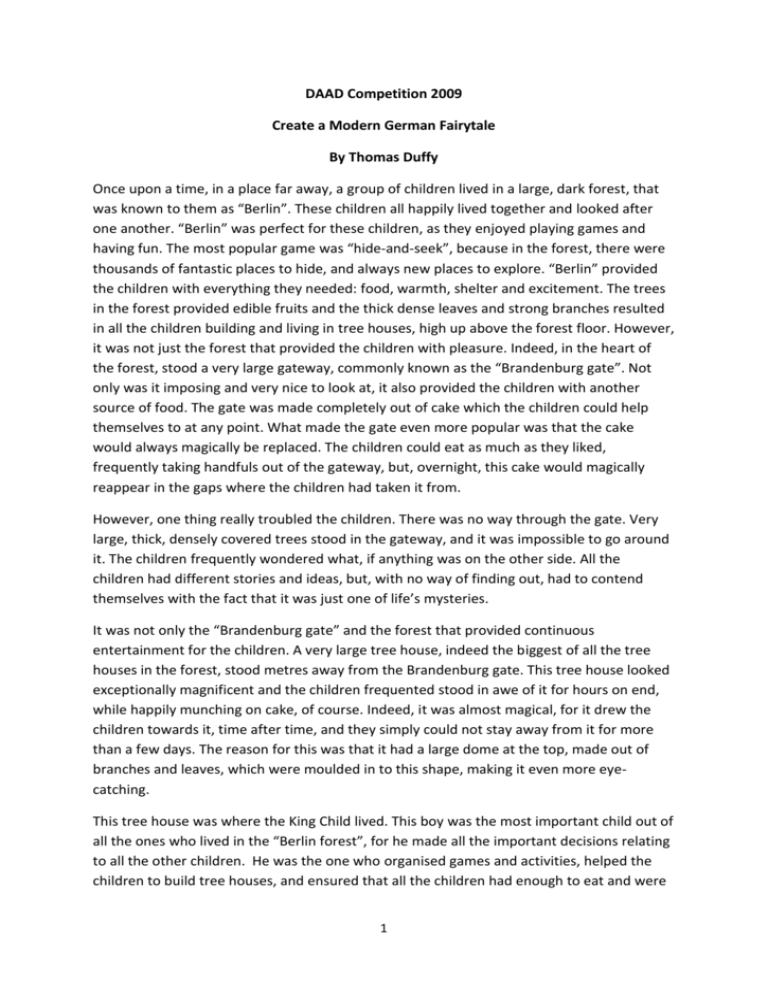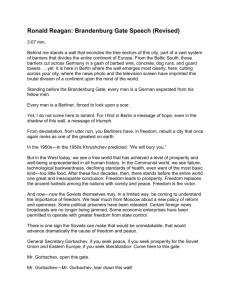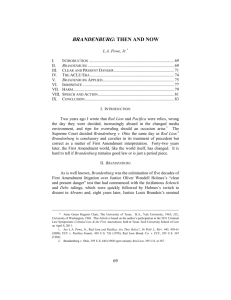The Berlin Forest
advertisement

DAAD Competition 2009 Create a Modern German Fairytale By Thomas Duffy Once upon a time, in a place far away, a group of children lived in a large, dark forest, that was known to them as “Berlin”. These children all happily lived together and looked after one another. “Berlin” was perfect for these children, as they enjoyed playing games and having fun. The most popular game was “hide-and-seek”, because in the forest, there were thousands of fantastic places to hide, and always new places to explore. “Berlin” provided the children with everything they needed: food, warmth, shelter and excitement. The trees in the forest provided edible fruits and the thick dense leaves and strong branches resulted in all the children building and living in tree houses, high up above the forest floor. However, it was not just the forest that provided the children with pleasure. Indeed, in the heart of the forest, stood a very large gateway, commonly known as the “Brandenburg gate”. Not only was it imposing and very nice to look at, it also provided the children with another source of food. The gate was made completely out of cake which the children could help themselves to at any point. What made the gate even more popular was that the cake would always magically be replaced. The children could eat as much as they liked, frequently taking handfuls out of the gateway, but, overnight, this cake would magically reappear in the gaps where the children had taken it from. However, one thing really troubled the children. There was no way through the gate. Very large, thick, densely covered trees stood in the gateway, and it was impossible to go around it. The children frequently wondered what, if anything was on the other side. All the children had different stories and ideas, but, with no way of finding out, had to contend themselves with the fact that it was just one of life’s mysteries. It was not only the “Brandenburg gate” and the forest that provided continuous entertainment for the children. A very large tree house, indeed the biggest of all the tree houses in the forest, stood metres away from the Brandenburg gate. This tree house looked exceptionally magnificent and the children frequented stood in awe of it for hours on end, while happily munching on cake, of course. Indeed, it was almost magical, for it drew the children towards it, time after time, and they simply could not stay away from it for more than a few days. The reason for this was that it had a large dome at the top, made out of branches and leaves, which were moulded in to this shape, making it even more eyecatching. This tree house was where the King Child lived. This boy was the most important child out of all the ones who lived in the “Berlin forest”, for he made all the important decisions relating to all the other children. He was the one who organised games and activities, helped the children to build tree houses, and ensured that all the children had enough to eat and were 1 happy. As the King Child, all the other children admired and respected him. He was the child that all the other children wanted to be like. One warm, sunny day, the children, who had become bored of playing hide-and-seek, and wanted to do some more exploring, decided to try and get through the thick, dense trees that blocked their entry through the “Brandenburg gate”. It was the brainchild of the King, but as he went about trying to break through, more and more children began to join him. All the children became intrigued at what lay on the other side of the gate. All the children worked for hours, cutting and squeezing their way through the forest’s thick branches, in the hope of eventually breaking through. Finally, after several days of hard work, the children broke through and came out on the other side of the “Brandenburg gate”. They simply couldn’t believe what they saw. The children discovered lots of tree houses identical to their own. They knew they didn’t live here, so who could they possibly belong to? The children were very confused. They explored the other side of the forest in complete amazement. And then they saw them. The other children. At first, both sets of children, ran behind trees for cover, unsure of what was happening, and who the other group were. But slowly but surely, both sets of children started to come out, their intrigue simply too great to resist. The children realised that they look exactly the same. Then they started speaking to each other. Both sets of children had had no idea of what had existed behind the “Brandenburg gate”. However, all the children were delighted to see each other, even if they were very confused at how they had ended up on the either side of a great divide. The two sets of children set about integrating with each other, exchanging stories and ideas about what has happened, which obviously resulted in them being split up many years ago. Many children came back with the children who had broken through the “Brandenburg gate”. The children started to play together and before long, had happily settled in to their new homes. After much hard work, the trees and branches that had stood in the “Brandenburg gate” were permanently cut back. This meant that the children could visit both sides of the forest and mix freely. Although the shock of discovering each other took a little getting used to, the children became even happier and had even more fun in the forest, safe in the knowledge that they had acquired new friends. They all knew that no divide would become between them ever again, and all the children lived happily ever after. 2









